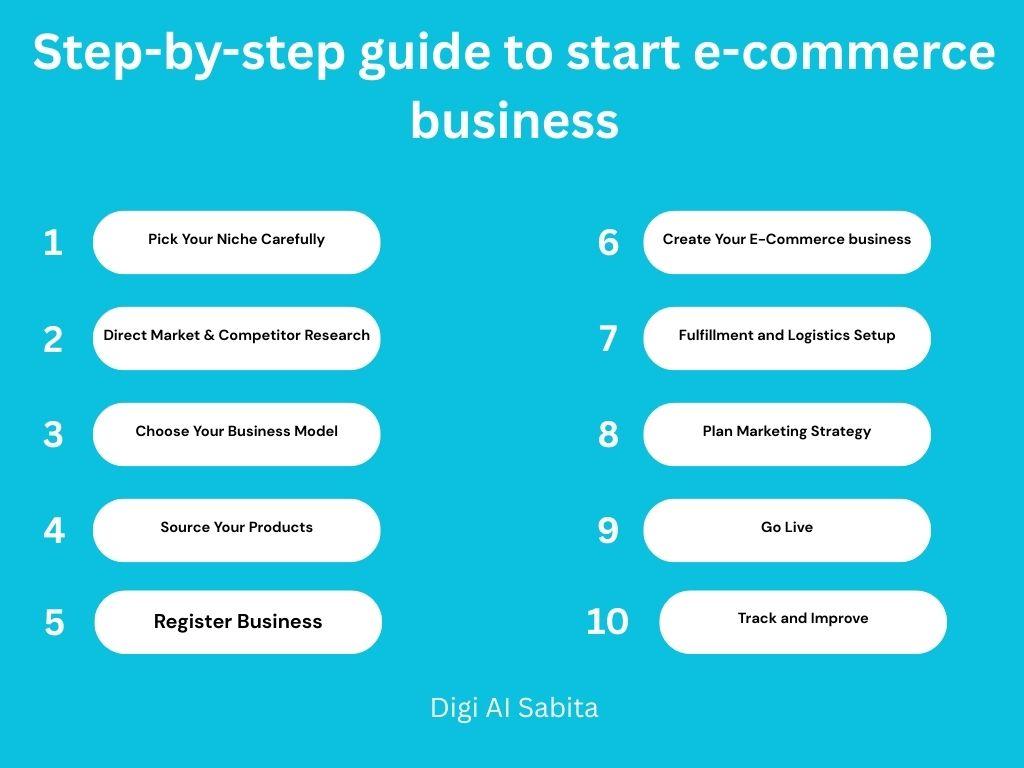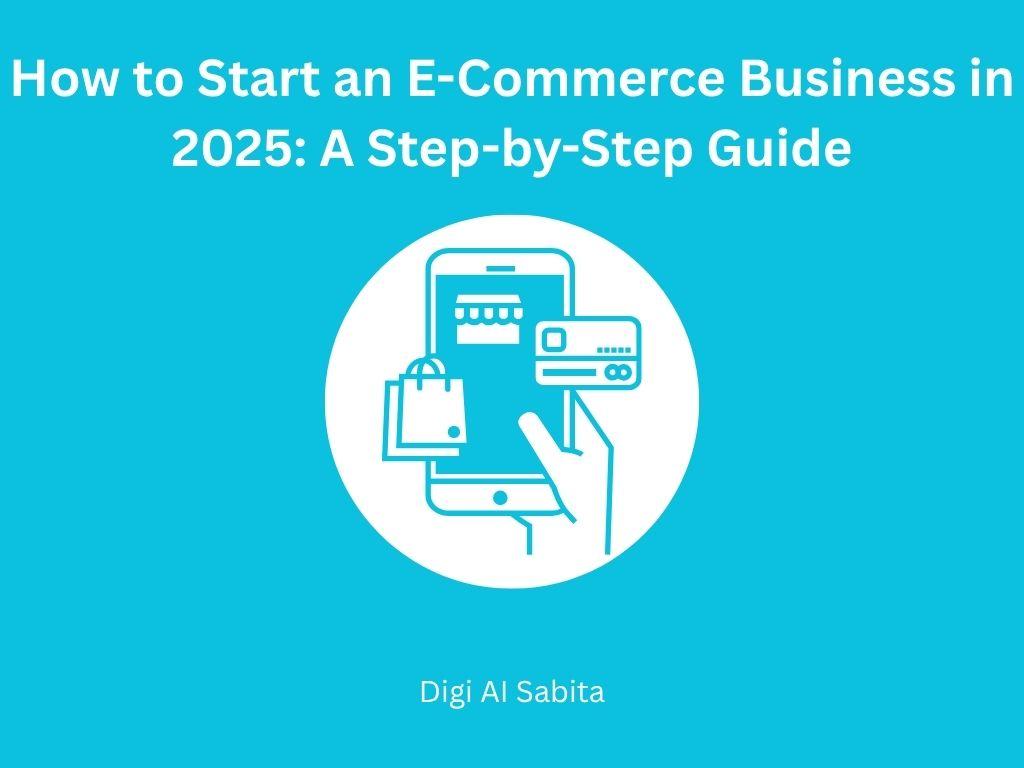Introduction: How to Start a Digital Business
The scope of e-commerce business is booming bigger than ever in 2025. More than 2.5 billion digital consumers now exist universally, and AI is recreating and identifying consumers’ behaviors. E-commerce is creating a wide range of opportunities for different companies. E-commerce success doesn’t by accident, but through strategy, tools, and having a clear plan.
Whether you’re a new entrepreneur or an existing store owner converting to e-commerce, this step-by-step guide will help you start a successful e-commerce business in 2025.
- Step-by-step guide to start e-commerce business
- Step 1: Pick Your Niche Carefully
- Step 2: Direct Market & Competitor Research for e-commerce business
- Step 3: Choose Your Business Model
- Step 4: Source Your Products
- Step 5: Register Business
- Step 6: Create Your E-Commerce business or shop
- Step 7: Fulfillment and Logistics Setup
- Step 8: Plan Marketing Strategy
- Step 9: Go Live
- Step 10: Track and Improve
- Conclusion: E-Commerce Business in 2025
- FAQs:
- Q1. Can we begin an e-commerce company in 2025?
- Q2. What will be the cost to begin an e-commerce company?
- Q3. Which are the best platforms for starting an e-commerce business in 2025?
- Q4. Do I need to learn coding in order to launch an e-commerce store?
- Q5. What are the most useful e-commerce trends for 2025 that I must follow?
- Q6. How do I detect the best product to sell online?
- Q7. Is it necessary to have a license to sell online in 2025?
- Q8. Can I do an e-commerce business part-time?
- Q9. How do I attract more traffic to my e-commerce site?
- Q10. When can I get a profit from this business?
- You may like:
Step-by-step guide to start e-commerce business

Here is a guide for a startup e-commerce business.
Step 1: Pick Your Niche Carefully
It’s essential to select the perfect niche that helps you grow fast. They are:
- It should be profitable.
- It shouldn’t be too difficult to understand.
- You should be interested and passionate about that chosen niche or topic.
Tips on Finding the Perfect Niche
- Use Google Trends, Trending Topics, to spot rising product categories.
- Check forums like Reddit or Quora to identify main points or unfulfilled needs.
- Look at Amazon bestsellers and Shopify’s trending products.
Step 2: Direct Market & Competitor Research for e-commerce business
Research is most important to find out the trending market and competitors. The main areas to research are
- Find out the competitor pricing & positioning.
- Take customer reviews to research what customers like or dislike about similar products.
- Use different tools like Ahrefs or SEMrush and ChatGPT to analyze competitor traffic source data summarization.
Step 3: Choose Your Business Model
E-commerce in 2025 provides some low-barrier entry models:
Popular E-Commerce Business Models:
- Take quick and low-risk.
- Personalize products like t-shirts and ship on demand.
- Resell under your label by purchasing from the manufacturer directly.
- Purchase on a large scale and resell them, adding your own value and tags.
- Sell courses, eBooks, or subscriptions.
Step 4: Source Your Products
After selecting a model, it’s time to reach for a source of quality products or suppliers.
The sourcing options are
- People from Alibaba or AliExpress
- Printify for print-on-demand
- Faire or Abound for wholesale sourcing
- Local or sustainable suppliers, relevant source
Step 5: Register Business
Now register the business to set it up in this way:
- Select a particular business name to verify domain availability.
- Register your business entity, like an LLC, sole proprietorship, etc.
- Obtain an EIN for U.S. businesses or international businesses.
- Set up a business bank account and a Stripe or PayPal account.
- Get sales tax permits registered if necessary in your area.
Step 6: Create Your E-Commerce business or shop
Now it’s time to build your e-commerce business. The top platforms are
- Shopify
- WooCommerce
- BigCommerce
- Squarespace
The store must have these features:
- Mobile-friendly, fast-loading design.
- Comprehensive product descriptions and high-quality images.
- Use an AI-powered chatbot or virtual assistant.
- Secure checkout with Buy Now Pay Later providers
- Customer reviews are important, so create an FAQ and return policy pages.
Step 7: Fulfillment and Logistics Setup
Fulfillment options are
- Self-fulfillment
- Third-party logistics
- Dropshipping
Step 8: Plan Marketing Strategy
The greatest products require exposure. Planning a market strategy is important to convert consumers into buying customers. The strategies are
- Content Marketing & SEO
- Social Media Marketing
- Influencer & UGC Campaigns
- Email Marketing
- Paid Advertisements
Step 9: Go Live
You should go live with certain planning. Some hints are given below:
- Establish a waitlist with lead magnets or early bird promotions.
- Promote a launch offer (i.e., a 15% or 20% discount offer for the starting 50 buyers).
- Collect at a live event or product demo on social media.
- Request reviews or testimonials immediately from satisfied buyers.
Step 10: Track and Improve
Tracking and improvement in collected resources help with growth.
- Traffic sources and bounce rates
- Sales conversion rates
- Customer behavior
- Ad performance
Conclusion: E-Commerce Business in 2025
A high-potential, low-barrier opportunity awaits to start an e-commerce business in 2025 if you do it with clarity and strategy. With the emergence of AI tools, automation, and creativity platforms, freelancers are able to go head-to-head with big brands.
Take your time to research, plan, and test. Prioritize building a brand that connects with your audience, provides value, and adapts to trends.
Call to Action
Ready to Launch Your Digital Store in 2025?
Get started with your e-commerce business today using our step-by-step guide. Whether you’re in the business of selling goods or services, this guide provides everything you need to achieve success.
Stay updated, and if you have any queries, you can e-mail us.
FAQs:
Q1. Can we begin an e-commerce company in 2025?
Yes, 2025 is a wonderful time to start. With growing digital use, improved tools, and minimal startup expenses, opening an online store has never been simpler.
Q2. What will be the cost to begin an e-commerce company?
Depending on your niche, it can start from $100 to $5,000, a platform like Shopify or WooCommerce, inventory, and an advertising plan.
Q3. Which are the best platforms for starting an e-commerce business in 2025?
The most trending platforms are Shopify, WooCommerce, Ecwid, BigCommerce, Wix, and Adobe Commerce. Select one that aligns with your technical competence, cost, and business model.
Q4. Do I need to learn coding in order to launch an e-commerce store?
No. All platforms have drag-and-drop builders and templates by means of which you can create a store without needing coding knowledge.
Q5. What are the most useful e-commerce trends for 2025 that I must follow?
These days, AI-based products are recommended, such as voice search optimisation, mobile-first design, sustainable products, and hyper-personalised marketing.
Q6. How do I detect the best product to sell online?
You can do market research, use AI tools like Google Trends or Amazon Best Sellers, and examine your competitors’ strategies. Prioritise fixing a problem or meeting a need.
Q7. Is it necessary to have a license to sell online in 2025?
Yes, most nations require a business license, tax ID, and perhaps a seller’s permit based on where you are and what type of product you sell.
Q8. Can I do an e-commerce business part-time?
Yes. It is a flexible type of business. Most successful e-commerce sites began as side businesses and expanded into full-time operations.
Q9. How do I attract more traffic to my e-commerce site?
You can operate traffic through SEO, social media ads, email marketing, sponsored ads (like Google or Meta), influencer collaborations, and content promotion.
Q10. When can I get a profit from this business?
It is not fixed, but the majority of new e-commerce companies are 6 months to a year old before they start making a profit, depending on strategy, investment, and niche demand.
